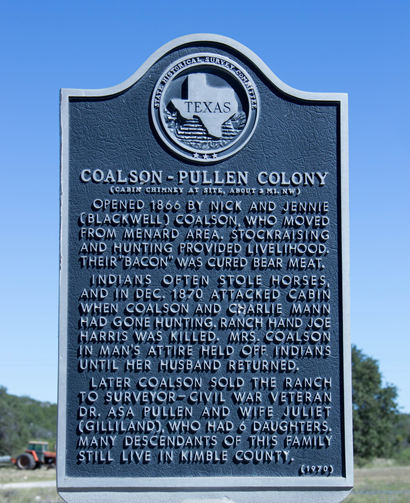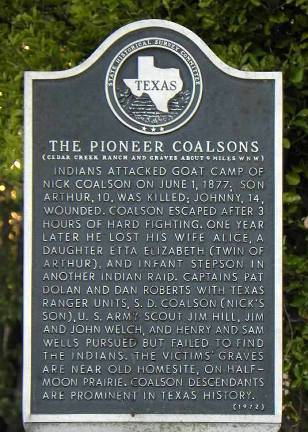|
|
Texas
| People
The Coalsons:
Frontier Family
Target of Multiple Indian Attacks
By Mike Patterson
|
|
A
tinge of winter chill hung in the air at the Coalson place on the
Texas frontier one dawn in December 1870 and life was already stirring
around the family's two-room cabin. Smoke curled from the chimney,
dogs bayed and men rode off to hunt for wolves.
Nick Coalson and his wife Jennie settled four years earlier at this
lonely spot at the junction of the East and West Copperas Creeks
in western Kimble
County. They had seven children, ages 1 through 11, including
a set of 3-year-old twins, Arthur and Mayetta Elizabeth.
This land of limestone plateaus cut by expansive valleys was once
dominated by the Comanches, a fierce tribe of nomadic Indians who
had terrified Texans with their vicious attacks on settlers and
settlements for decades. The warfare had quieted down by now, and
except for the occasional stolen horse, there had not been a significant
Indian raid in the vicinity for some time. Patrols from Fort
McKavett, a cavalry and infantry base 20 miles north, tended
to keep a lid on Indian raiding parties.
Natives of Illinois, Nick and Jennie Coalson moved to Texas at the
start of the Civil War. First, they settled near Jacksboro,
then moved to the San Saba River region near Menard
and finally ended up on Copperas Creek. They raised a few cattle,
hogs and chickens and grew corn on a 10-acre patch cleared out of
the brush. But the large family subsisted mainly on bear, deer,
wild turkey and an assortment of other game that flourished in this
Texas Eden.
Sharing their cabin with the family was Charlie Mann, a teacher
for the children, and Joe Harris, a hired hand, his wife and baby.
This morning, Coalson and Mann left early on their wolf hunting
excursion while Harris worked in the field. The older Coalson children
played outside. Jennie, Mrs. Harris and the infants remained in
the cabin.
The alarm was sounded by a neighbor standing on a distant bluff.
"Get in the house!" he shouted. "The Indians are coming!"
Fifteen Indians swarmed out of the brush and headed toward the cabin.
The children dashed inside. Jennie slammed and barred the door behind
them.
She told the children stay quiet, hoping they would leave them alone.
The Indians amused themselves by riding the calves and hogs and
shooting arrows at the chickens.
Tired of this escapade, they approached the cabin and tried to beat
down the door. The women fired a pistol to summon help.
"Nick, did you hear that shot?" Mann asked his hunting companion.
"Yes," Coalson responded, "that's Jennie shooting squirrels for
dinner, or maybe soldiers from Fort
McKavett." Nevertheless, they turned their horses toward home
to investigate the commotion.
Harris heard the same warning shot. Unarmed, he ran toward the cabin
but was cut down and scalped as he darted through the yard gate.
Witnessing her husband's slaughter, Mrs. Harris let out a piercing,
horrified scream.
A crack shot, Jennie aimed a shotgun through a slit in the wall
and blasted the nearest Indian with buck-shot. Her eldest son, Stephen,
begged her to let him have a shot but the Indian slipped out of
sight.
After dragging their fallen comrade away, the Indians prepared to
set the cabin on fire.
Jennie then employed a ruse: She donned her husband's coat, pulled
his hat down over her forehead and cracked the door just enough
for the Indians to get a good glimpse. She dropped her voice several
octaves and in a coarse, masculine tone fiercely cursed the attackers.
This gave the Indians pause: They thought it was a man inside.
A mile or so away, Coalson and Mann were still unaware of the attack
taking place at home. Thinking the nearby shots were from Fort
McKavett soldiers out for a merry time, Mann yelled in the direction
of the gunfire, "Look out which way you're shooting. You're liable
to hit somebody."
When the bullets buzzed even closer, they realized they had ridden
into an ambush. "That's Indians!" Coalson shouted.
They spurred their horses and galloped to the cabin, dodging gunfire
and arrows the entire way. Mann's horse was hit and fell dead as
they reached the yard. Coalson and Mann scrambled through the door
without a scratch.
With the armed men inside, the Indians broke off the attack and
faded into the brush. Soldiers arrived around midnight, gave chase
but the Indians had scattered and their trails lost.
Today, about 3 miles north of IH-10 west of Junction,
an historical marker on FM 1674 stands near the rock-strewn river-bed
of Copperas Creek. It marks the nearby site of the Coalson's cabin
and commemorates her role in masquerading as her husband to hold
off an Indian attack.
|
 |
On FM 1674 "about
3 miles north of IH-10 west of Junction"
Photo courtesy Mike Patterson, October 2014 |
Copperas
Creek
Photo courtesy Mike Patterson, October 2014 |
|
Jennie Coalson
bravely held off the Indians in 1870 but died in 1875. "Few women
or men ever spent a more active and useful frontier life than did
this noble character," wrote author, attorney and former U.S. Rep.
O.C. Fisher.
After
her death, Coalson moved again, this time farther south to the Half-Moon
Prairie near the Nueces River in Edwards
County. He took up raising goats and found a new wife, Alice
Humphreys.
On June 1, 1877, Coalson and two sons, John, 14, and the twin Arthur,
now 10, were tending their goat herd at a remote camp at the head
of Cedar Creek, a Nueces tributary. The boys were "having a great
time fighting bumblebees," John recalled in an interview in the
Frontier Times magazine.
"It was about 2 p.m. and the first we knew of any Indians was when
they began shooting at us with their six-shooters," he said. John
and Arthur ran toward their father in camp. After they had gone
about 30 yards, John remembered he was carrying a "cap-and-ball
pistol." He stopped, turned and fired at the nearest Indian. He
missed.
The Indian fired at John, hit him between the shoulders and "knocked
me down. The Indian then came running up, unbuckled my gun belt,
and took it and my gun and my hat," he said. The rest of the Indians
rode over him, shooting as they passed. Another bullet hit him in
the left arm.
They chased down Arthur, shot and killed him. Then they hit the
sheep camp where they besieged Coalson for three hours before he
escaped and dashed six miles to home.
John lay where he had fallen and pretended like he was dead. The
attackers returned to check on him. "When I heard them, I thought
my time had come, sure enough," he said. They turned him over, and
opened his shirt and then rode off, still suspicious that he wasn't
dead. "I was lying there with my arms over my face, but was watching
them as they left. They left one of my knees sticking up when they
turned me over. I kept it that way as long as I could" before letting
it fall to the ground. One Indian saw this, paused and watched for
a moment or two before riding on.
Burning with thirst under the scorching Texas sun, he crawled to
a small pool of water held in a basin of rocks and drank. This invigorated
him enough to make it to the goat camp. He poured a water barrel
into another hole in the rocks. He wallowed in the pool all night
to relieve the fever caused by his gunshot wounds. Later the next
morning, Texas Rangers found him and treated his wounds. He eventually
recovered.
The Indians were believed Apaches from across the Rio Grande in
Mexico. By now, they had scattered in six directions, making it
impossible to track them.
A
year later, almost to the day, Coalson, Alice, and two children,
including the couple's infant boy, rode to a creek three miles from
their home to gather grapes. John and a sister, Lula, stayed behind.
On the way back, the family divided into two groups. Coalson followed
a shorter trail to drive his milking cows home; Alice and the children
took the longer wagon road.
Nick arrived home first. John asked him where the others were. When
they didn't show up, John recalled, "I felt that something must
be wrong." Nick stayed with Lula while John searched for the missing
family members.
About three-quarters of a mile down the road, "I saw something white
in the road. I knew it didn't belong there. The further I went,
the more frightened I got."
He found the body of Arthur's twin sister, Elizabeth, in her white
underwear with arrow sticking in her back. The red dress she had
worn that day had been torn off. John turned and ran back to the
house.
Returning with his father, they found the bodies of Alice and her
one and a half year old son.
Texas Rangers chased the Indians past Junction,
Brady and near
Menard
before they finally slipped away.
Having suffered three Indian attacks in Texas and the loss of a
wife and three children, Nick took his family to New Mexico where
he died in June 1919.
Their continued bouts with the Indians earned the Coalsons a second
state historical marker, ½ mile north of the Nueces River on Texas
55, near Barksdale.
|
 |
Fisher summed
up the family's experience on the often brutal and tragic Texas range:
"Perhaps no frontier family tasted the bitter cup of Indian savagery
as did the Coalson family."
© Mike Patterson
Guest Column, January 9, 2015
About the author:
Mike Patterson is a San
Antonio-based freelance writer. He has written for the New York
Times Travel Section, Texas Parks & Wildlife Magazine, AAA Texas Journey
and AAA New Mexico Journey magazines, New Mexico Magazine, The NonProfit
Times, Planned Giving Today and the Southwest Historical Quarterly
and is a frequent contributor to the Church News, published by the
Episcopal Diocese of West Texas. Early in his career he worked as
an editor and reporter for United Press International, the late Dallas
Times Herald and the Fort Worth Star-Telegram. He recently retired
after a more recent career in the non-profit sector, including stints
at Trinity University and the Arthritis Foundation. He holds a bachelor
of journalism degree from the University of Texas at Austin
and a master's degree from the University of Missouri School of Journalism.
He can be reached at rmp231@gmail.com.
Sources:
It Occurred in Kimble by O.C. Fisher
Historical Markers, FM 1674 and SH 55
Frontier Times
Handbook of Texas online
Indian Depredations in Texas by J.W. Wilbarger
Findagrave.com |
| Texas
Escapes, in its purpose to preserve historic, endangered and vanishing
Texas, asks that anyone wishing to share their local history
and vintage/historic photos, please contact
us. |
|
|